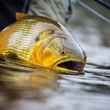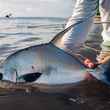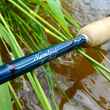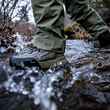Staying warm when fishing during harsh winter conditions means staying safe, but it also means staying on the water longer. And while self preservation might not be ingrained in all anglers, the desire to log more hours on the water typically is. But staying both safely warm and comfortable while outdoors and active during wintertime can sometimes be complicated.
Conditions during the icy winter months can vary wildly throughout the day. The harsh, single-digit temperatures that might greet an angler on a dimly lit, breezy morning can, by midday, be replaced by a comparatively balmy, wind-free, sunbleached 35 degree afternoon. If an outing on the water was limited to only one of these hypothetical scenarios, the gear one would choose for each would be dramatically different.
An angler’s activity level can also significantly impact one’s choice of winter gear. Park-and-play vs. hike-in, hard vs. easy wading, walk-and-wade vs. drift boat and so on—all of these aspects of your gameplan can also play a determining role in how you choose your winter gear.
The secret to handling all of these variables without a detailed review of water temperatures and wind forecasts, scrutinizing the day’s solar energy profile, nagging your buddy for the number of trail miles you’re expected to log, a scientific calculator and so on, is layering.
Outer Layers
For anglers, choosing your lower outer layer is easy: your waders. If you have multiple choices, choose your bulkier, warmer waders for winter wear. That is, unless they’re too snug to allow you to fit your other winter layers underneath, in which case you should choose the roomier pair.
Choose your upper outer layer based mainly on the precipitation forecast. If you’re expecting any chance of rain or snow, be entirely sure your outer layer is waterproof. Not water-resistant or “weatherproof” — waterproof. If you’re wet when it’s cold, it’s typically game over. So always prioritize staying dry above all other concerns. Yes, most waterproof outer layers will provide little to no warmth and don’t breathe particularly well. But that’s okay. You can always add an extra mid-layer for warmth and shed your waterproof layer when there’s no water falling from the sky.
Look with confidence at the Patagonia River Salt Jacket (pictured at top) and the Orvis PRO Wading Jacket, both of which are loaded with angler-friendly features, pack down well (for when you need to shed and stow it) and, most importantly, keep wetness at bay.
If you’re lucky enough to be graced with a dry day on the river, you can leave the waterproof layer in your truck or your bag (but never at home) and opt for an outer layer that offers some serious, warmth-giving (or, more accurately, warmth-keeping) insulation.
Most of the time and especially if we’re not donning a waterproof outer layer, we’ll opt for a synthetically insulated outer layer vs. a down one. Nothing beats the insulating power of down, but down has a serious weakness that anglers repeatedly subject it to: wetness. Down loses the bulk of its insulating power when it gets wet, while many synthetic alternatives don’t. Naturally, most of the brands that make gear for anglers are tuned into this fact, and thus the options here abound.

Orvis’ PRO Insulated Hoody offers serious warmth but breathes extremely well, thanks to a design aimed at active anglers which features Primaloft Gold insulation on the core and Polartech Alpha on the side panels. Equally appropriate for anglers looking for serious breathability is Patagonia’s Tough Puff line, which is an angler-aimed (and warmer) version of its Nano Air jackets. Simms ExStream BiComp Hoody—which features a Primaloft Gold insulated upper with a thin, spandex-like lower for reducing bulk under your waders—was a layering godsend for many and it doubles particularly well as a mid-layer on those days when you need a waterproof outer. Of course, there’s always the indispensable Patagonia Nano Puff which “hatches” along rivers from coast to coast sometime around October, thanks to its incredible versatility and packability.

Middle Layers
Most winter layering treatises treat the individual layers in a winter layering system as singularities. 1 + 1 + 1 = 3. But in some scenarios—particularly the seriously cold ones—we prefer to double up on midlayers.
There are countless options when it comes to upper mid-layers — synthetic zip-ups and pullovers, fleeces, slim-fit jackets, quilted down overshirts, sweaters, wool shirts and much, much more. Typically, though, we confine our midlayer choices to two categories, due primarily to their excellent warmth-to-bulk ratios: synthetic zip-ups and pullovers and the oft-forgotten, somewhat old-fashioned, decidedly un-trendy wool shirt.

For synthetics, Patagonia’s R1—which features a Polartec fabric exclusive to Patagonia—has been around forever and keeps getting better with each iteration. We’re also big fans of Stio’s Wilcox Fleece Hoody. And don’t forget the aforementioned Simms ExStream BiComp, which does superb midlayer duty when the conditions call for it.
Whatever happened to wool shirts? Button-down wool shirts have been a staple in cold-weather wear for hundreds of years and we so no reason to toss them aside now. They’re remarkably versatile, comfortable and do double duty as street and active wear. Patagonia made a stellar, 100% wool shirt a few years back, but has since shifted to wool-synthetic blends. There’s nothing wrong with the blended versions (which are still primarily wool), but if you ever stumble on the 100% wool versions—grab them up fast. We’re going on year 10 with ours, and they still look like new. Similar alternatives don’t grow on trees the way they used to, but there are some very nice options from the likes of Topo Designs, L.L. Bean, Woolrich and Pendleton.

Our favorite combo for those truly frigid days mixes a synthetic mid-layer with a basic wool shirt. On the not-so-cold days? Take your pick of the synthetic or wool mid-layer and stowe the loser in your vehicle in case you underestimated nature’s fury.
If the temps are seriously low, you’ll want to add a lower mid-layer as well. That means under-wader pants. Back in December, we told you about the superb Patagonia Shelled Insulator Pants, which we’ve spent half the winter in thus far. More recently, we were turned on to the Orvis PRO Underwader Pants which are seriously warm, seriously comfortable, low-bulk and even feature a stirrup (try it, you’ll like it) to keep them from riding up the leg of your waders.

Baselayers
Though baselayer tops and bottoms are essential components of any layering setup, there’s little reason to spend too much time searching for the perfect baselayer. Our go-to has long been Smartwool Merino Wool Baselayers but several of the fishing-focused apparel makers have you covered as well. Patagonia’s Capilene system is one plenty of anglers, climbers, skiers and more swear by. Simms has an extensive mix of baselayer options, including their Lightweight Core Bottoms which we’ve found less prone to causing overheating than many other options out there. And don’t be afraid to look at “budget” options from lesser known manufacturers, many of those get the job done just fine.
Whatever options you choose, choose ones that allow the flexibility to stay dry, comfortable, warm and, most importantly, on the water. Oh, and we can’t say it enough: when it’s cold outside, always leave the cotton at home.
































Comments
Gregory Howard replied on Permalink
All good info on protecting yourself with clothing, but 38 years of being a paid Ski Patroller I have picked up a couple hacks to protecting myself and staying warmer. First hack is using antiperspirant on your feet to reduce sweating. Second is taking a shower the night before to allow your body oils to recover to stay warmer and not screw your body thermostat. Third is using Dermatone, in the tin, to protect your face/lips from windburn and frostnip. I never use a face mask in order to prevent fogging of my googles and the Dermatone has served me well in sub-zero conditions. Additionally benefit of Dermatone is it has a SPF of 15.
Glenn Dotter replied on Permalink
Once again the writer gives good info on staying warm. Unfortunately by virtue of all the brand names, he says you must spend a fortune. The brands he mentions are all the premier high dollar brands. If you bought the gear he mentions, yup you would be warm but you would have spent a fortune.
I've been hunting and flyfishing for over 60 years and I'm here to tell you, you dont have to spend a fortune to stay warm. As a guy who isn't independently wealthy, you don't have to look like you just walked out of one of the name brand flyfishing stores or high priced fly shop to be warm. It continues to irk me that writers want you to believe that if you are not spending a fortune on you gear, you can't catch fish. I see and watch guys who have the best rods, reels, line, waders, boots, and clothing, flail away, trying to look the part, but not catch fish. You young people starting out, dont need to spend a fortune to get into the sport. The famous name stores import alot of that expensive gear largely from the far east and that means cheap and even slave labor makes it and the they charge you a fortune for it.
I would love to see just 1 writer spend an article writing about all the inexpensive yet quality gear out there on the market.
Leonard Fancher replied on Permalink
cotton kills
Pages